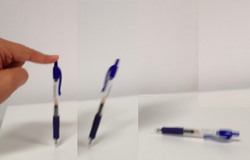Pens Have Other Uses Too
 I assume that you work through these problems using some sort of writing utensil. Take your pen, balance it on its tip, and let go. It falls over. How fast in
m/s
is the other end of the pen going when it hits the table, assuming the tip doesn't slip? Take the pen to be a uniform one dimensional rod of length 15 cm.
I assume that you work through these problems using some sort of writing utensil. Take your pen, balance it on its tip, and let go. It falls over. How fast in
m/s
is the other end of the pen going when it hits the table, assuming the tip doesn't slip? Take the pen to be a uniform one dimensional rod of length 15 cm.
The answer is 2.1.
This section requires Javascript.
You are seeing this because something didn't load right. We suggest you, (a) try
refreshing the page, (b) enabling javascript if it is disabled on your browser and,
finally, (c)
loading the
non-javascript version of this page
. We're sorry about the hassle.
Consider the pen to be a thin rod having uniform mass distribution over its length
Let m = Total mass of pen
l = length of pen = 1 5 c m
ω = angular velocity of pen when it hits the table
Initially when the pen is held vertical, the center of mass of pen is 2 l c m above the level of table and when it is released, it rotates about it's bottom tip and hits the table by which the height of center of mass of pen becomes zero w.r.t table
Let y 1 = Initial height of the center of mass w.r.t table = 2 l c m
y 2 = Final height of the center of mass w.r.t table = 0 c m
Hence,the change in gravitational potential energy of pen is responsible for the rotational motion of pen about its lower tip.
∴ K = 2 1 I ω 2 = Rotational Kinetic energy of the pen
Where, I = 3 m l 2 = Moment of Inertia of pen about its bottom tip
Hence, by using work energy theorem,
(change in gravitational potential energy of pen) + (Rotational Kinetic energy of the pen) = 0
∴ m g ( y 2 − y 1 ) + 2 1 I ω 2 = 0 where g = Gravitational acceleration = 9 . 8 m s − 1
∴ m g ( y 1 − y 2 ) = 2 1 I ω 2
∴ m g ( 2 l − 0 ) = 2 1 3 m l 2 ω 2
∴ ω = l 3 g
Let v = velocity of upper end of the pen when it hits the ground = ω l = l 3 g l = 3 g l
= 3 × 9 . 8 × 1 5 × 1 0 − 2 m s − 1 = 2 . 1 m s − 1